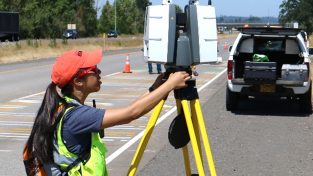Today’s surveyors are more than just surveyors – they are business professionals, digital connoisseurs, legal analysts, and all around renaissance men and women. In this episode, we speaking with Craig Hill from Leica Geosystems to discuss ever-evolving nature of the profession.
BK: Today’s surveyors are more than just surveyors; they are business professionals, digital connoisseurs, legal analysts, and all-around Renaissance men and women. Welcome to HxGN Radio. My name is Brian. And today we have Craig Hill, vice president of Geomatics Marketing at Leica Geosystems, here to discuss the ever-evolving nature of the surveying profession. Craig, thanks for joining us.
CH: Thank you. Happy to be here.
BK: Appreciate it. Let’s start off with a little bit of an overview of the surveying profession today, and also, what is the current state of it?
CH: Well, I would say that the surveying profession is currently very buoyant. With a worldwide construction boom, there is plenty of work for surveyors. The challenge to the profession, however, is that the average age of surveyors is rapidly increasing. The average age of the professional surveyor in the U.S., for example, is currently 59 years old. It has become increasingly important to do more with less. That’s where technology comes in. Only with constantly evolving technology are we able to keep up, making it possible to do more with less.
BK: So, you’re a surveyor by background. You’ve got more than 20 years in the profession. Your doctorate thesis was on combining terrestrial and satellite surveying. What have you witnessed in the evolution of this profession? I mean, you’ve mentioned that things are changing and trying to get things a little bit “less is more” kind of thing.
CH: It’s nearly more than 20 years since I was in university, and back then, we were trained on both analog and digital surveying equipment. Using analog equipment helped in the understanding of the measurement principles, but more so, it has developed into a much bigger appreciation of modern surveying equipment. A good example is how we used to measure distances with a steel chain and needed to make corrections for temperature and apply the correct tension to the chain. But now, distances are all measured electronically, with all corrections being automatically applied onboard the total station. Another example is photogrammetry. We study this field up in university, but only a few used the knowledge after graduating. Today, however, with unmanned aerial vehicles, or UAVs, photogrammetry, using UAV aerial images to create point clouds that can be used for mapping and volumetric calculations, has become widespread. Further, to point clouds, now with terrestrial laser scanners, 2 million points per second are collected with millimeter accuracy. This was unthinkable 20 years ago and is revolutionizing reality capture. My first encounter with GPS satellite positioning was in the middle of the night. In those days, the GPS satellites were only available for a short period of time, which often happened in the middle of the night. Since then, the constellation of satellites has significantly increased over the years, and the surveying profession has embraced the technology, enabling them to increase their productivity by doing more with less.
BK: Love it. So, we mentioned that surveyors have become Renaissance men and women, which is cool. I mean, you’re doing a lot of things, but why do you think that they have become Renaissance professionals?
CH: Well, in the early days, surveyors could be thought of as pioneers, really charting the uncharted. This has changed significantly over the years. No longer are days or weeks required to bring accurate coordinates to new areas. This can now be performed with GPS or GNSS positioning in a matter of minutes, if not, even seconds. But surveyors need to embrace modern technologies to succeed. The modern surveyor now often becomes the data manager, playing an instrumental role in coordinating and managing the digital progression of a project.
BK: Now, you were part of a research project at Leica Geosystems that specifically looked at the needs of surveyors today. What did you learn, and how has that affected the profession now?
CH: Yeah, well, it’s still early days; we haven’t yet completed the analysis. But what is clear, with a 95% agreement, surveyors are telling us that new technologies have made them more efficient at work. Furthermore, we see that total stations and GPS, GNSS technologies are becoming commonplace, with more than 90% utilization; followed by laser scanners, with over 60%; and UAVs, with 40% utilization. This clearly shows that surveyors are embracing the latest technologies. Another interesting finding is the topic of the aging profession. More than 50% of the responses said that they would recommend surveying as a profession to family or friends.
BK: Hm, interesting. Good. Good to hear that. So, how is Leica Geosystems in supporting the evolution of the profession as well?
CH: Well, at Leica Geosystems, we understand that surveyors need to do more with less, and are continuing to invest in product development to make our customers more productive. A recent example is the release of the Leica GS18 T, GNSS RTK rover, that no longer requires the pole to be held vertical. With the integration of the IMU, Inertial Measurement Unit, the tilt of the pole is measured and significantly speeds up the measurement process. Our customers are telling us that productivity increases of over 20% are being achieved because of this innovation. At the other end of the spectrum, we routinely support the FIG, or the International Federation of Surveyors, the Young Surveyors group, and support universities and colleges with the supply of the latest technology, equipment, and software to be used in their education programs.
BK: Excellent. Where do you think surveying’s going to be going in the future, at this point?
CH: Yeah, well, surveying is no longer for university-educated professionals only. With technology making fieldwork easier, many surveying tasks can be completed by appropriately trained personnel. The professional surveyor will more likely become the data and the project manager and a key stakeholder in selecting the correct equipment to get the job done, using the personnel available.
BK: Exciting future. Sounds like things have really come along in the last few years, which is awesome, so great to hear about that. Any last thoughts?
CH: Well, being passionate about surveying and the surveying profession myself, I asked my nine-year-old daughter, “Would you ever think of becoming a surveyor?” She responded, “No,Papa. That’s too boring. I want to be a pastry chef.” So, luckily, I’m also passionate about pastry.
BK: Good. Well, there you go. So, you’ve got pastry, and then you’ve got surveying. Two options, right there. That’s great. Craig, thanks so much for your time. Appreciate it. Great Information. Thank you for sharing all of this.
CH: Thank you.
BK: For more information on today’s topic, please visit leica-geosystems.com. And, of course, to learn even more and to listen to additional episodes, head over to hxgnspotlight.com. Thank you for joining us here on HxGN Radio.
















